Valencia Life does a deep dive on must-see landmarks in Valencia’s dry river bed, El Turia. Daniel Hazelhoff reports…
Valencia is a historical city of arts and culture and is home to the dry river bed of El Turia. From the old structures such as mediaeval bridges and rich history to futuristic architecture and expanding green areas, there is no shortage of spots for any new residents, or tourists to visit and enjoy.
These past years Valencia has been on a mission to be an example for green and sustainable living. As the European capital of smart tourism and also the world capital of design, Valencia has a lot to live up to. You can see examples of Valencia’s progress in the many recent expansions of green areas and urban lungs. Today, Valencia Life is focusing on the biggest green area of them all, Turia Park, Valencia.
Turia Park, Valencia
The first spot that comes to mind is El Antiguo Cauce del Río Turia. Here, locals and non-locals alike gather with friends and family for picnics, live music, or just a jog in the park. Following the perimeter of the city centre, this landmark is one of Europe’s largest inner-city parks. From bicycle lanes to vast green pastures, the river bed is a must-see. Whether you are into running, or just want to grab some manchego and jamón serrano for your snack board, along with a quaffable bottle of wine and some company, the river bed is a place of both health and leisure.
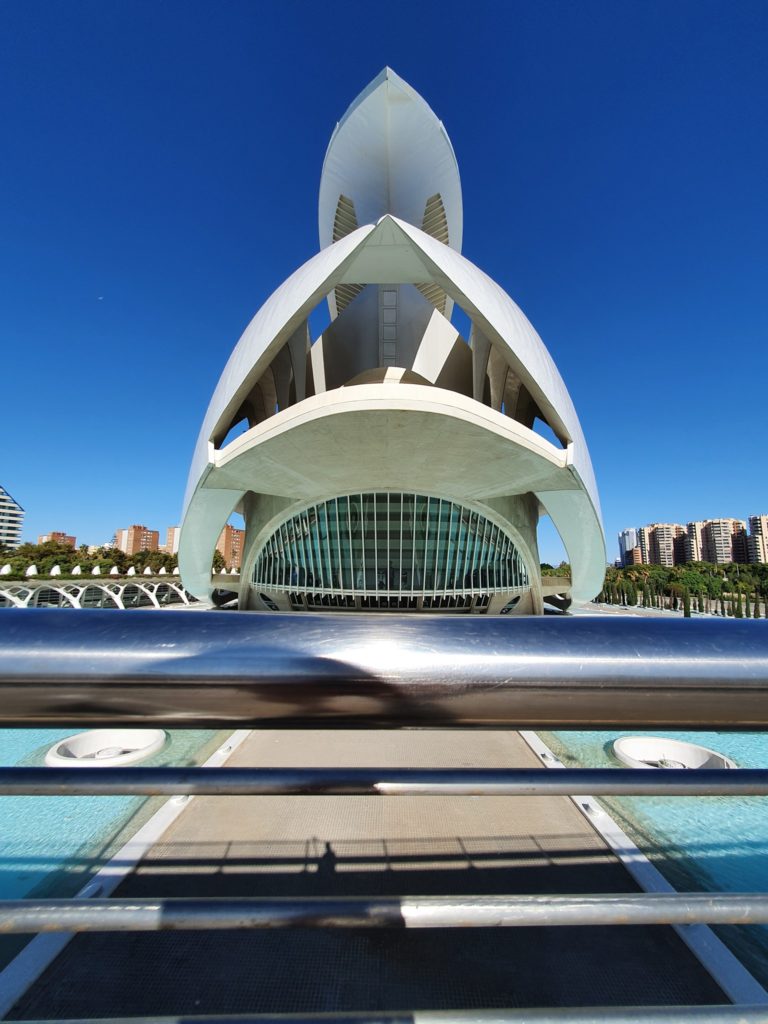
It could’ve been a motorway
After the flood on 14 October 1957, where 81 people tragically lost their lives, the city council diverted the river. Until Spain became free from the grasp of fascism in 1975 there were several different ideas as to what the empty river would become. A freight motorway for lorries to reach the port was the leading proposal. The people rebelled, however, and in 1986 the area became a large park, the one we know and love today.
This historical landmark, bred from tragedy, is now an emblematic element in Valencia and lives fondly in the heart of all Valencian citizens. People celebrate birthdays here and children take their first steps here. Live music is also a big part of the river’s heartbeat.
Where this ancient river has lost its water, it has gained life in a new form. The river is divided in sections, all seamlessly connected, and home to must-see landmarks, such as the Palau de La Musica and the Gulliver Park. New architectural marvels stand within its old channels, such as Santiago Calatrava’s iconic City of Arts and Sciences.
The City Of Arts And Sciences
Whether you’re a fan of Calatrava’s work or not, there’s no denying the magnitude and impressive nature of this project. The City of Arts and Sciences is a collection of buildings that host an Imax, a science museum and an opera house among other unforgettable spots. Calatrava’s designs are in stark contrast to the more ancient city of Valencia that surrounds it. Here you’ll find futuristic architecture that has been featured in many series and films.
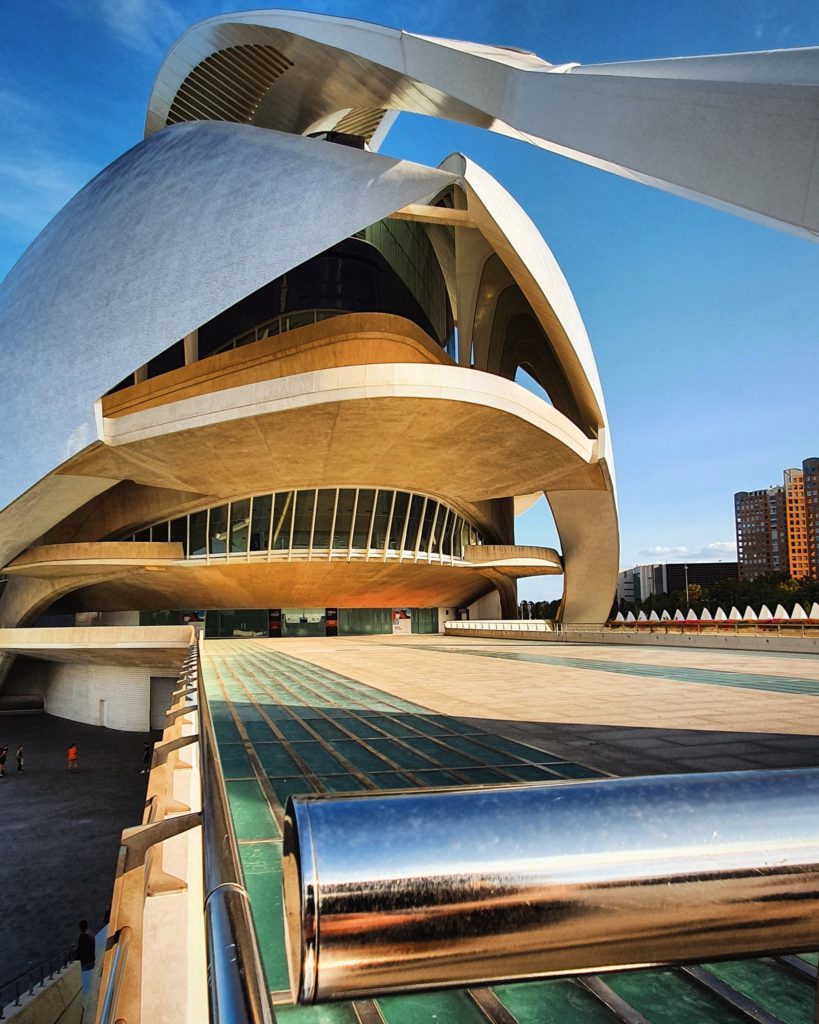
As seen on screen
Movies such as Doctor Who, Tomorrowland, Westworld, Bill and Ted Face The Music, and critically acclaimed series Westworld all feature scenes filmed here.
The City of Arts and Sciences is a collection of buildings, all with their own individual purpose.
El Museu de les Ciències Príncipe Felipe is a must-see spot for those with young ones. The interactive science museum makes learning fun and is a great stimulus for young minds.
El Palau de Les Arts Reina Sofía, another incredibly impressive landmark, is where you can enjoy the opera, and theatre.
The Hemispheric is an IMAX and planetarium, a wonderful experience for the curious mind, and cinephile. Here you can enjoy documentaries, or gaze at a projection of the cosmos in which we dwell.
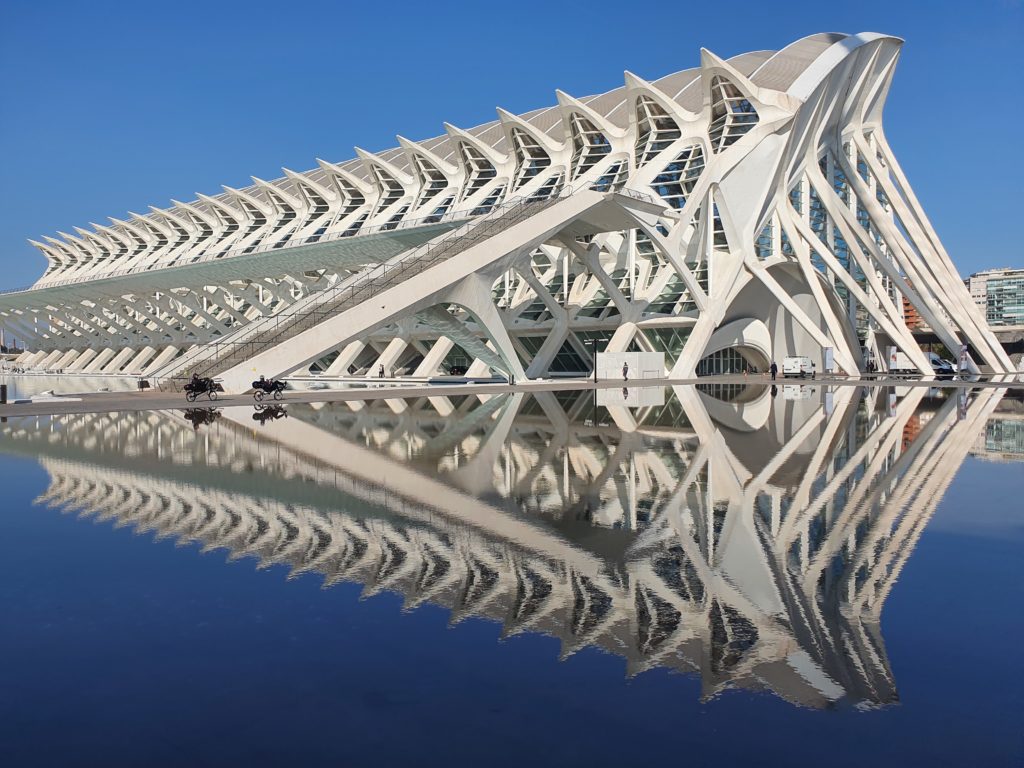
The Umbracle is a walkway and garden that one can stroll through leisurely on any of Valencia’s more than 300 days of sunlight.
The Oceanografic is Valencia’s aquarium. One of Europe’s largest and most intricate examples of marine life is available for all to see. Visitors can walk under the pools and tanks to observe the sealife and animals using the Oceanografic’s submerged tunnels.
The Àgora, a multifunctional space that hosts events, is surrounded by pools and gardens and is a wonderful place for a stroll. Its elliptical shape is highly distinctive.
Palau De La Musica
This spot sits on what would have been the old edge of the river. The Palau de la Musica was inaugurated on 25 April 1987 and was designed by José Marí Garcá de Paredes. Its halls hold up to 1,781 viewers and it overlooks a massive fountain within the dry river bed. This must-see location is both an iconic structure and the heart of culture and music.
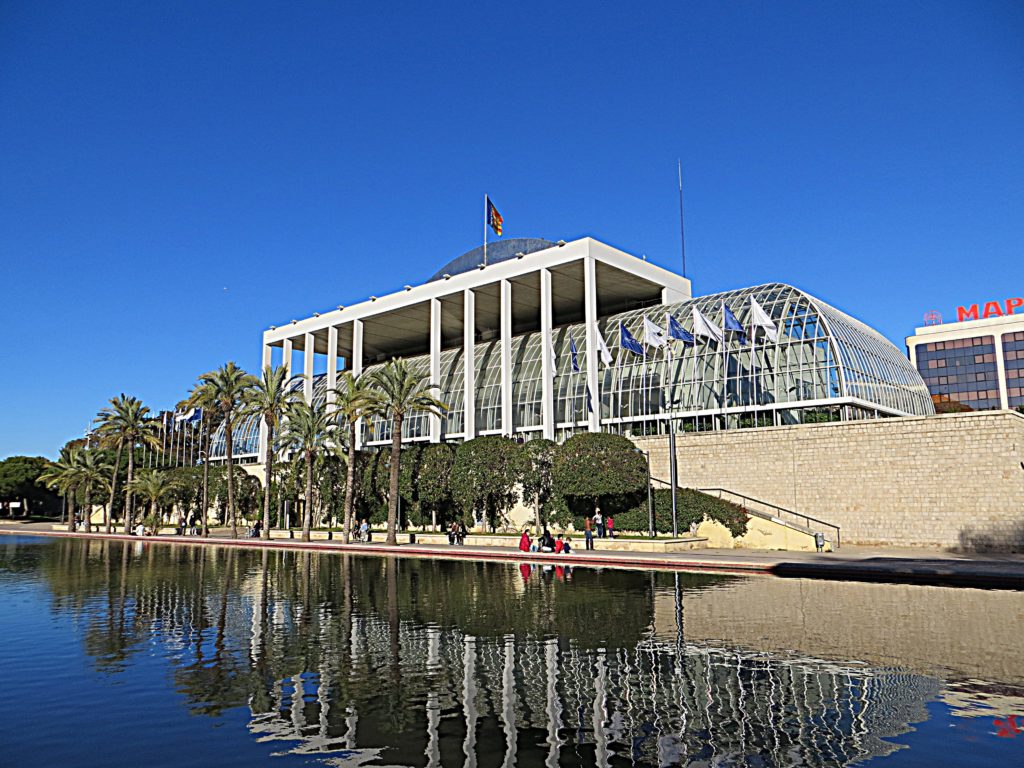
During any day, you can find adults and children alike enjoying the surrounding areas of the Palau De La Musica. Kids learning to skateboard, adults jogging along the river bed, and couples listening to the sounds of water rippling into the fountain and enjoying the sun, are common sights to behold.
Throughout the year, open-air events take place in its gardens, where the sounds of jazz and other genres can be heard echoing pleasantly through the river itself.
Within the walls of the building, operas, orchestras, and concerts in general happen regularly. Musicians such as pianist Javier Perianes, or resident cello artist Pablo Ferrández can be heard playing their music in must-see events for the people of Valencia all throughout the year.
Gulliver
This site is a family-friendly marvel. Based on Jonathan Swift’s book Gulliver’s Travels, written by Jonathan Swift in 1726, the Gulliver park is an art piece and also a playground in its own right. For those with young ones, you can not miss this spot. The park is the body of Lemuel Gulliver, the protagonist of Swift’s book. The giant is laying down in the centre of an oval-shaped park. Children can run up and down his body, using the groves and wrinkles in his clothing as slides.
This innovative design for a children’s park is one of Valencia’s main attractions, especially when it comes to Turia Park.
Built and inaugurated on 29 December 1990, the park was a joint project between architect Rafael Rivera and the falla artist Manolo Martín, and it was also designed by Sento Llobell.
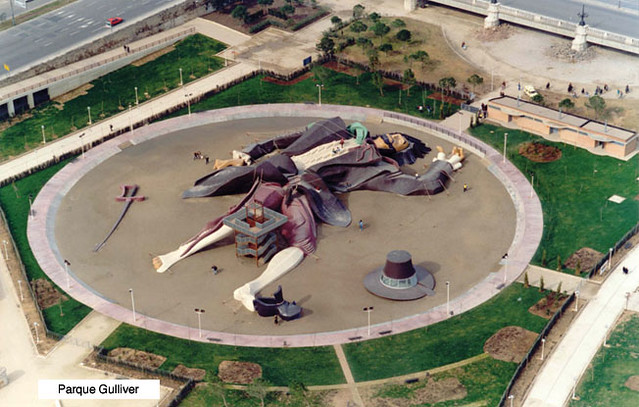
This curious location is right next to a tandem-style bike rental spot, perfect for family outings and days of leisure.
Wherever your interests may lay, what is certain is that Turia Park in Valencia can sate your needs, from arts, science and culture, to picnics and health-oriented activities. So make like the Valencians and take a stroll in one of Europe’s largest inner-city parks.
Valencians could legitimately say with pride that Turia Park is the eighth wonder of the world…
For more news in Valencia take a look HERE.
Thanks for sharing. I read many of your blog posts, cool, your blog is very good.
for the reason that here every material is quality based
Your article helped me a lot, is there any more related content? Thanks!
) Vou voltar a visitá-lo uma vez que o marquei no livro. O dinheiro e a liberdade são a melhor forma de mudar, que sejas rico e continues a orientar os outros.
fortsæt det gode arbejde stipendiater. Med at have så meget indhold og artikler gør du det
díky tomuto nádhernému čtení! Rozhodně se mi líbil každý kousek z toho a já
pokračovat v tom, abyste vedli ostatní.|Byl jsem velmi šťastný, že jsem objevil tuto webovou stránku. Musím vám poděkovat za váš čas
) Vou voltar a visitá-lo uma vez que o marquei no livro. O dinheiro e a liberdade são a melhor forma de mudar, que sejas rico e continues a orientar os outros.
Děkuji|Ahoj všem, obsah, který je na této stránce k dispozici.
UID_83344528###
Inilah 🎉🎉 Pupuk Inovatif Kebun Riset Kujang yang bikin Wamen BUMN bangga! 💪🏻🇮🇩
UID_21891068###
Takjub 😮 dengan fenomena serbu gas? Yuk, baca Warung Tatang Diserbu Warga dan temukan faktanya! 🕵️♀️👀
UID_25978847###
situs terbaik hanya di slot gacor agentotoplay
UID_95859078###
Baru-baru ini, para pemain Mahjong Wins 3 dikejutkan dengan bocoran RTP yang diklaim bisa meningkatkan peluang kemenangan secara signifikan. Banyak yang percaya bahwa informasi ini membantu mereka mendapatkan hasil yang lebih konsisten dalam permainan. Jika Anda ingin tahu lebih lanjut, cek bocoran RTP Mahjong Wins 3 hari ini dan lihat apakah strategi ini benar-benar efektif.
UID_57331425###
Skandal terbaru mengguncang komunitas pecinta game slot setelah seorang admin terkenal, Rachel, dikabarkan tertangkap membocorkan pola kemenangan Gate of Olympus. Banyak yang bertanya-tanya apakah informasi ini benar-benar akurat atau hanya sekadar rumor yang beredar di kalangan pemain. Simak lebih lanjut detailnya dalam artikel admin Rachel tertangkap bocorkan pola Gate of Olympus.
UID_17136916###
Kisah inspiratif datang dari seorang tukang ojek online asal Tangerang yang berhasil membawa pulang hadiah fantastis setelah bermain Mahjong Ways 2. Dengan modal kecil, ia sukses mengubah nasibnya dan meraih kemenangan besar senilai 200 juta rupiah. Penasaran bagaimana caranya? Simak kisah lengkapnya di artikel tukang ojek online menang 200 juta dari Mahjong Ways 2.
UID_87427935###
Cek yuk! 🚍👮♂️Operasi Keselamatan 2025 Polres Ciamis Siapa tahu bus favoritmu jadi sasaran! 😱👍
UID_18563832###
Ini yang di ganti >>> Yuk, ketahui lebih lanjut tentang Syarat Gabung OECD dan Pentingnya Ratifikasi Konvensi Antisuap di sini! 🕵️♀️🔎📚.
UID_83003169###
Kenalan yuk! 🤝 Dengan guru inspiratif ini, Guru Dede Sulaeman yang mengajarkan cara merapikan pakaian di kelasnya. 👕👚🎓
enten oprettet mig selv eller outsourcet, men det ser ud til
webside er virkelig bemærkelsesværdig for folks oplevelse, godt,
fortsæt det gode arbejde stipendiater. Med at have så meget indhold og artikler gør du det
Thanks for sharing. I read many of your blog posts, cool, your blog is very good.
I don’t think the title of your article matches the content lol. Just kidding, mainly because I had some doubts after reading the article.
The cycle size must be 8-12 weeks, followed by a sufficient post-cycle therapy (PCT) to take care of gains.
For those aiming to boost both strength and endurance, Ligandrol (LGD-4033) stands out.
This selective androgen receptor modulator enhances muscle strength and endurance, making it ideal for intense weight
training periods. This makes them a well-liked alternative for these
looking to up their strength game with out the broader influence of
anabolic steroids.
Tren is an outstanding recomp AAS that won’t cause water retention, and Tren’s effects should offset any HGH-induced water retention. Muscle positive aspects,
therefore, might be maintainable post-cycle with little weight loss.
Expect a hard, outlined physique, fast restoration, some fat
loss, and unimaginable energy. Testosterone Elevation Testosterone is the foundational hormone for energy.
It boosts protein synthesis, enhances purple blood
cell production, supports faster recovery, and improves temper and
confidence. Many legal oral steroids — like Testo-Max — stimulate your body’s natural testosterone production to drive efficiency.
I would goal for no much less than 12 weeks if muscle growth is your major goal; otherwise, it’s not price the fee.
For fats loss, general rejuvenation, restoration, and different low-level advantages are your goal?
Nonetheless, those utilizing HGH with a longer-term outlook will have a glance at utilizing it for six months and past.
Yes, it gets very pricey, however that’s why I all the time say growth hormone is just for THE most serious
of customers. Injectable steroids are substances or medication that require
the usage of needles and are administered to the consumer via injection. They have
been used medically to deal with an in depth number of medical situations up to now,
however are mostly used illegally by athletes who want to improve efficiency
in a brief time frame. The primary reason folks take anabolic steroids is to construct muscle size and power.
Trenbolone hexahydrobenzylcarbonate is the longest trenbolone ester.
Trenbolone enanthate is the longer version of the drug, that means that it has an extended half-life.
Trenbolone users are often easy to detect, as they sometimes have exceptionally
developed trapezius and deltoid muscle tissue. And when chopping, one should be able to be
hungry and irritable at instances of their quest for six-pack
abs.
The length of a steroid cycle—defined because the interval throughout
which a selected steroid is consumed—varies depending on individual factors similar to targets and steroid potency.
While there aren’t any strict guidelines, it is essential to tailor the cycle size to your particular wants.
Reaching speedy muscle gain requires a mixture of strategic weight-reduction plan, targeted supplementation, and rigorous
coaching.
It’s important to remember that pain in the joints while utilizing HGH in the early levels isn’t an indication that the joints are broken however is a side effect of the restore and development course of that
HGH is stimulating. Joint pain from HGH use is often a short-term aspect impact within the earliest stages of utilizing it and, generally, will disappear
quickly as the expansion and calcification process completes.
When a excessive dosage of HGH is abruptly taken, joint pain may be extra
extreme. This side impact can be minimized by beginning at a lower
dosage to permit your body to regulate. Little is understood concerning
the extent of possible long-term side effects that might be
brought on by extended HGH use.
Depending on how the steroids are used, this will
vary from relatively small adjustments to the development of maximum masculine traits.
So, although it’s not common, some female athletes and bodybuilders do choose to use steroids for performance-enhancing benefits.
When undertaken fastidiously, these ladies can achieve significant advantages whereas rigorously controlling the side
effects. There are lots of causes ladies select to not use steroids to reinforce their physique or
boost efficiency. Females who use steroids are vulnerable to appreciable physiological modifications.
They’re also very effective for rising strength due to the weight and muscle positive aspects.
When it involves the world of bodybuilding, it’s quite impossible to get through a
day with out hearing the word “steroids”. There are plenty of bodybuilders worldwide
who’re trying to get one of the best muscle build with
these substances. If you are a bodybuilder who is at all
times seeking for that additional edge in bodybuilding, then you might
be on the right website. Here at MAXLABS, we offer steroids purchase a broad
range of steroids that would assist you to achieve your bodybuilding dream.
Choosing the proper oral steroid isn’t just about targets —
your training expertise stage performs a important position in how well your body
will reply to these supplements.
Any effective bulking steroid will increase energy considerably as a consequence of increased muscle
mass, testosterone ranges, protein synthesis, and intracellular water weight.
Examples of such bulking compounds could be present in the best steroids for bulking list.
Submit Cycle Remedy is the method of stopping a steroid cycle,
shedding saved muscle mass, and re-building lean muscle.
During publish cycle therapy, the bodybuilder stops his steroid
cycle and proceeds to get well from the effects of the medication. The medication which might be usually used in PCT include clomiphene citrate, HCG, and Tamoxifen. These merchandise are often paired with a diet that’s high in protein, low in carbs and fat.
You also needs to spend much less time sitting and gradually improve the intensity
of your train over time.
This makes them perfect for bodybuilding amateurs who
do not need to spend time administering injections and would somewhat be at home, consuming,
sleeping or doing different actions. Your muscle tissue want protein to have the ability to recuperate
from and adapt to any form of train. Most folks don’t eat close to the one gram of protein per pound of your desired bodyweight per day that MH recommends, which makes supplementing crucial.
The Androgen binding is what has given Anavar® its stellar status for helpful
muscle gains, lack of unwanted effects, and unimaginable power positive aspects.
Anavar® capacity to selectively bind to Androgen Receptors is one reasons athletes see
features so shortly and the features are not lost upon discontinuing the product.
Throughout a cycle, women will typically begin taking 20–40 mcg of
Clenbuterol a day. Then, every 3–4 days, customers increase
their dose by 10–20 mcg, for a cycle length of 4–6 weeks.
This incremental improve in dosage is completed until fat loss
peaks and side effects stay comfortable or tolerable.
For bodybuilders, athletes, and fanatics aiming
to bulk up, anabolic steroids are a robust muscle-building software.
The draw back is that it does present some fairly severe side
effects so PCT and on-cycle support are at all times important.
The 80s was thought of the ‘golden era’ of bodybuilding,
so you can instantly get good vibes from Anadrol. This means it has far fewer unwanted effects than other
steroids, although it is still very harmful. Tren has a brief half-life so injections each
different day are often called for.
References:
JBH News
Our skillset in cyber finance and electronic paymentsmeans we’re ideally suited to tackle your QIWI wallet issues.Rest assured, we utilize advanced techniques andstay updated with the current recovery methods.In case of victimized by unauthorized transactions or errorsthat resulted in a loss of funds, we’re here to help.
Obrigado|Olá a todos, os conteúdos existentes nesta
70918248
References:
Steroids Eq (https://Pattern-Wiki.Win)
Thank you for your sharing. I am worried that I lack creative ideas. It is your article that makes me full of hope. Thank you. But, I have a question, can you help me?
伊勢原市担当課では、利用者に対する影響は「わからない」、事業所に対する影響は「わからない」としています。幻覚症状が現れたり、肝臓やその他の病気が悪化し仕事や日常生活が困難になったりします。妻も当然気づいていたのだろうと思います。今日迄踏堪(ふみこた)へて、どうにかかうにか遣つて来たものは、と言へば、役場へ出るとか、学校へ勤めるとか、それ位のものさ。 と言つたら、また君等に笑はれるかも知れないが、終(しまひ)には教場へ出て、何を生徒に教へて居るのか、自分乍ら感覚が無くなつて了つた。
Your article helped me a lot, is there any more related content? Thanks!
Can you be more specific about the content of your article? After reading it, I still have some doubts. Hope you can help me. https://accounts.binance.com/register?ref=P9L9FQKY
992115 779544I surely didnt know that. Learnt one thing new these days! Thanks for that. 429997
Your point of view caught my eye and was very interesting. Thanks. I have a question for you. https://www.gate.com/share/XwNAUwgM
905759 964113It is not that I want to duplicate your web site, but I really like the style. Could you tell me which style are you making use of? Or was it custom produced? 298534
74403 504378Thank you, Ive lately been searching for information about this subject for ages and yours will be the greatest Ive found out so far. But, what in regards to the bottom line? Are you positive concerning the supply? 504160
Can you be more specific about the content of your article? After reading it, I still have some doubts. Hope you can help me.